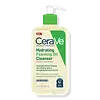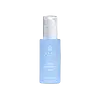What's inside
What's inside
 Key Ingredients
Key Ingredients

 Benefits
Benefits

 Concerns
Concerns

 Ingredients Side-by-side
Ingredients Side-by-side

Water
Skin ConditioningGlycerin
HumectantPEG-200 Hydrogenated Glyceryl Palmate
CleansingCoco-Betaine
CleansingDisodium Cocoyl Glutamate
CleansingPEG-120 Methyl Glucose Dioleate
EmulsifyingPolysorbate 20
EmulsifyingPEG-7 Glyceryl Cocoate
EmulsifyingSqualane
EmollientCeramide NP
Skin ConditioningCeramide AP
Skin ConditioningCeramide EOP
Skin ConditioningCarbomer
Emulsion StabilisingTriethyl Citrate
MaskingSodium Chloride
MaskingSodium Hydroxide
BufferingSodium Cocoyl Glutamate
CleansingSodium Benzoate
MaskingSodium Lauroyl Lactylate
EmulsifyingSodium Hyaluronate
HumectantCholesterol
EmollientCitric Acid
BufferingCapryloyl Glycine
CleansingHydroxyacetophenone
AntioxidantCaprylyl Glycol
EmollientCaprylic/Capric Triglyceride
MaskingTrisodium Ethylenediamine Disuccinate
Phytosphingosine
Skin ConditioningXanthan Gum
EmulsifyingBenzoic Acid
MaskingPEG-150 Pentaerythrityl Tetrastearate
EmulsifyingPPG-5-Ceteth-20
EmulsifyingPEG-6 Caprylic/Capric Glycerides
EmulsifyingWater, Glycerin, PEG-200 Hydrogenated Glyceryl Palmate, Coco-Betaine, Disodium Cocoyl Glutamate, PEG-120 Methyl Glucose Dioleate, Polysorbate 20, PEG-7 Glyceryl Cocoate, Squalane, Ceramide NP, Ceramide AP, Ceramide EOP, Carbomer, Triethyl Citrate, Sodium Chloride, Sodium Hydroxide, Sodium Cocoyl Glutamate, Sodium Benzoate, Sodium Lauroyl Lactylate, Sodium Hyaluronate, Cholesterol, Citric Acid, Capryloyl Glycine, Hydroxyacetophenone, Caprylyl Glycol, Caprylic/Capric Triglyceride, Trisodium Ethylenediamine Disuccinate, Phytosphingosine, Xanthan Gum, Benzoic Acid, PEG-150 Pentaerythrityl Tetrastearate, PPG-5-Ceteth-20, PEG-6 Caprylic/Capric Glycerides
Water
Skin ConditioningGlycerin
HumectantIsopentyldiol
HumectantButylene Glycol
HumectantBetaine
Humectant1,2-Hexanediol
Skin ConditioningCarbomer
Emulsion StabilisingPropanediol
SolventTromethamine
BufferingPolyglyceryl-10 Laurate
Skin ConditioningAmmonium Acryloyldimethyltaurate/Vp Copolymer
Ethylhexylglycerin
Skin ConditioningSodium Hyaluronate
HumectantDisodium EDTA
Parfum
MaskingXylitylglucoside
HumectantAnhydroxylitol
HumectantHydrolyzed Hyaluronic Acid
HumectantXylitol
HumectantGossypium Herbaceum Seed Extract
Skin ConditioningGlucose
HumectantSodium Acetylated Hyaluronate
HumectantWater, Glycerin, Isopentyldiol, Butylene Glycol, Betaine, 1,2-Hexanediol, Carbomer, Propanediol, Tromethamine, Polyglyceryl-10 Laurate, Ammonium Acryloyldimethyltaurate/Vp Copolymer, Ethylhexylglycerin, Sodium Hyaluronate, Disodium EDTA, Parfum, Xylitylglucoside, Anhydroxylitol, Hydrolyzed Hyaluronic Acid, Xylitol, Gossypium Herbaceum Seed Extract, Glucose, Sodium Acetylated Hyaluronate
 Reviews
Reviews

Ingredients Explained
These ingredients are found in both products.
Ingredients higher up in an ingredient list are typically present in a larger amount.
Carbomer is a polymer of acrylic acid. Its main role is to create a gel consistency.
A high amount of carbomer can cause pilling or balling up of products. Don't worry, most products contain 1% or less of carbomer.
Glycerin is already naturally found in your skin. It helps moisturize and protect your skin.
A study from 2016 found glycerin to be more effective as a humectant than AHAs and hyaluronic acid.
As a humectant, it helps the skin stay hydrated by pulling moisture to your skin. The low molecular weight of glycerin allows it to pull moisture into the deeper layers of your skin.
Hydrated skin improves your skin barrier; Your skin barrier helps protect against irritants and bacteria.
Glycerin has also been found to have antimicrobial and antiviral properties. Due to these properties, glycerin is often used in wound and burn treatments.
In cosmetics, glycerin is usually derived from plants such as soybean or palm. However, it can also be sourced from animals, such as tallow or animal fat.
This ingredient is organic, colorless, odorless, and non-toxic.
Glycerin is the name for this ingredient in American English. British English uses Glycerol/Glycerine.
Learn more about GlycerinSodium Hyaluronate is hyaluronic acid's salt form. It is commonly derived from the sodium salt of hyaluronic acid.
Like hyaluronic acid, it is great at holding water and acts as a humectant. This makes it a great skin hydrating ingredient.
Sodium Hyaluronate is naturally occurring in our bodies and is mostly found in eye fluid and joints.
These are some other common types of Hyaluronic Acid:
Learn more about Sodium HyaluronateWater. It's the most common cosmetic ingredient of all. You'll usually see it at the top of ingredient lists, meaning that it makes up the largest part of the product.
So why is it so popular? Water most often acts as a solvent - this means that it helps dissolve other ingredients into the formulation.
You'll also recognize water as that liquid we all need to stay alive. If you see this, drink a glass of water. Stay hydrated!
Learn more about Water